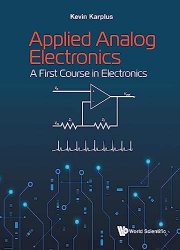Applied Analog Electronics: A First Course in Electronics
- Добавил: literator
- Дата: 30-07-2023, 17:05
- Комментариев: 0
 Название: Applied Analog Electronics: A First Course in Electronics
Название: Applied Analog Electronics: A First Course in ElectronicsАвтор: Kevin Karplus
Издательство: World Scientific Publishing
Год: 2023
Страниц: 616
Язык: английский
Формат: pdf (true)
Размер: 88.0 MB
This textbook is for a first course on electronics. It assumes no prior electronics experience, but does assume that students have had calculus 1 (single-variable differential calculus) and high-school physics. A key idea of the course is that students need a lot of design experience and hands-on work, rather than a lot of theory. The course is centered around the labs, which are a mix of design labs and measurement/modeling labs. This unique volume takes students from knowing no electronics to being able to design and build amplifier and filter circuits for connecting sensors to microcontrollers within 20 weeks. Students design a digital thermometer, a blood-pressure meter, an optical pulse monitor, an EKG, an audio preamplifier, and a class-D power amplifier. They also learn how to measure and characterize components, including impedance spectroscopy of a loudspeaker and of electrochemical electrodes.
I’ll try to keep the theory and the math to a minimum, introducing just enough to make the designs in the labs possible. Students wishing to go on to more advanced electronics courses will need to follow this course with a conventional electrical engineering (EE) circuits course, which provides the math and theory in abundance. EE circuits courses are usually taught as applied math courses, preparatory to later using the math to do design. That can work well if you later take design courses that use it, but is pretty useless if you stop with just the math and never do design. If you only take one electronics course, it should be one that does a lot of design, not one that prepares you for something you then don’t do.
This book was originally created for a course for bioengineers, not electrical engineers. The justification for an electronics course for bioengineers can be summed up in one word: sensors. A sensor is a device that converts some physical or chemical property of interest into a more easily measured or recorded property, generally an electrical parameter: a voltage, a current, a resistance, a capacitance, an inductance, and so forth. That electrical property can be amplified, filtered, and manipulated by electronic circuits, after which it is usually converted to a numeric value that can be recorded on a computer or in a lab notebook.
This class focuses on circuits needed to connect common sensors to computers, where the information can be processed, recorded, or acted on. Because this is a first course in electronics, not a computer engineering course, we will look only at sensors that produce one-dimensional analog outputs, not more sophisticated sensors like digital cameras nor digital interfaces like I2C and SPI. That is not to say that such topics are unimportant, just that they are beyond the scope of this course. This course emphasizes analog electronics that converts the signal from whatever the sensor produces to a voltage that can be read by a low-cost computer.
We’ll cover several different sensors: thermistors for measuring temperature, microphones for sound, electrodes for converting ionic current to electronic current (including EKG measurements), pressure sensors for breath pressure or blood pressure, and phototransistors for light measurements (for optical pulse monitoring). There are, of course, other applications of electronics, and we’ll look at one of them: audio amplification of sound waves. In addition to sound being a useful signal type for bioengineering work, it is pedagogically convenient, as students are already familiar with sound and electronic devices for dealing with sound.
Who the book is for:
This book and the course it is associated with are intended for anyone who wants a practical introduction to electronic circuits. We work at the op-amp level, not the transistor level, so that simple models are sufficient for most of the design work. Because of the math and physics requirements, the course is aimed primarily at sophomores in college, but it should be accessible to interested high-school students who have had calculus. Generally, students who have had single-variable differential calculus (AP Calculus AB) should have no trouble with any of the math in this book, and students might be able to get by with a good deal less math. Facility with simple algebra and fractions is essential, though.
Скачать Applied Analog Electronics: A First Course in Electronics
[related-news] [/related-news]
Внимание
Уважаемый посетитель, Вы зашли на сайт как незарегистрированный пользователь.
Мы рекомендуем Вам зарегистрироваться либо войти на сайт под своим именем.
Уважаемый посетитель, Вы зашли на сайт как незарегистрированный пользователь.
Мы рекомендуем Вам зарегистрироваться либо войти на сайт под своим именем.
